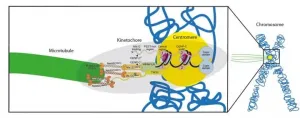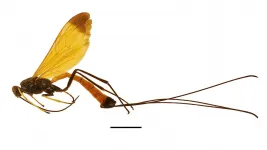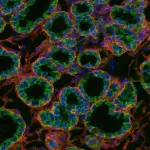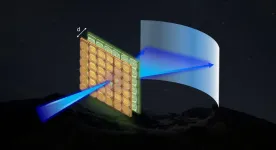(Press-News.org) WASHINGTON -- If you've ever tried to capture a sunset with your smartphone, you know that the colors don't always match what you see in real life. Researchers are coming closer to solving this problem with a new set of algorithms that make it possible to record and display color in digital images in a much more realistic fashion.
"When we see a beautiful scene, we want to record it and share it with others," said Min Qiu, leader of the Laboratory of Photonics and Instrumentation for Nano Technology (PAINT) at Westlake University in China. "But we don't want to see a digital photo or video with the wrong colors. Our new algorithms can help digital camera and electronic display developers better adapt their devices to our eyes."
In Optica, The Optical Society's (OSA) journal for high impact research, Qiu and colleagues describe a new approach for digitizing color. It can be applied to cameras and displays -- including ones used for computers, televisions and mobile devices -- and used to fine-tune the color of LED lighting.
"Our new approach can improve today's commercially available displays or enhance the sense of reality for new technologies such as near-eye-displays for virtual reality and augmented reality glasses," said Jiyong Wang, a member of the PAINT research team. "It can also be used to produce LED lighting for hospitals, tunnels, submarines and airplanes that precisely mimics natural sunlight. This can help regulate circadian rhythm in people who are lacking sun exposure, for example."
Mixing digital color
Digital colors such as the ones on a television or smartphone screen are typically created by combining red, green and blue (RGB), with each color assigned a value. For example, an RGB value of (255, 0, 0) represents pure red. The RGB value reflects a relative mixing ratio of three primary lights produced by an electronic device. However, not all devices produce this primary light in the same way, which means that identical RGB coordinates can look like different colors on different devices.
There are also other ways, or color spaces, used to define colors such as hue, saturation, value (HSV) or cyan, magenta, yellow and black (CMYK). To make it possible to compare colors in different color spaces, the International Commission on Illumination (CIE) issued standards for defining colors visible to humans based on the optical responses of our eyes. Applying these standards requires scientists and engineers to convert digital, computer-based color spaces such as RGB to CIE-based color spaces when designing and calibrating their electronic devices.
In the new work, the researchers developed algorithms that directly correlate digital signals with the colors in a standard CIE color space, making color space conversions unnecessary. Colors, as defined by the CIE standards, are created through additive color mixing. This process involves calculating the CIE values for the primary lights driven by digital signals and then mixing those together to create the color. To encode colors based on the CIE standards, the algorithms convert the digital pulsed signals for each primary color into unique coordinates for the CIE color space. To decode the colors, another algorithm extracts the digital signals from an expected color in the CIE color space.
"Our new method maps the digital signals directly to a CIE color space," said Wang. "Because such color space isn't device dependent, the same values should be perceived as the same color even if different devices are used. Our algorithms also allow other important properties of color such as brightness and chromaticity to be treated independently and precisely."
Creating precise colors
The researchers tested their new algorithms with lighting, display and sensing applications that involved LEDs and lasers. Their results agreed very well with their expectations and calculations. For example, they showed that chromaticity, which is a measure of colorfulness independent of brightness, could be controlled with a deviation of just ~0.0001 for LEDs and 0.001 for lasers. These values are so small that most people would not be able to perceive any differences in color.
The researchers say that the method is ready to be applied to LED lights and commercially available displays. However, achieving the ultimate goal of reproducing exactly what we see with our eyes will require solving additional scientific and technical problems. For example, to record a scene as we see it, color sensors in a digital camera would need to respond to light in the same way as the photoreceptors in our eyes.
To further build on their work, the researchers are using state-of-art nanotechnologies to enhance the sensitivity of color sensors. This could be applied for artificial vision technologies to help people who have color blindness, for example.
INFORMATION:
Paper: N. Tang, L. Zhang, J. Zhou, J. Yu, B. Chen, Y. Peng, X. Tian, W. Yan, J. Wang and M. Qiu, "Nonlinear Color Space Coded by Additive Digital Pulses," Optica, 8, 7, 977-983 (2021).
DOI: https://doi.org/10.1364/OPTICA.422287.
About Optica
Optica is an open-access, journal dedicated to the rapid dissemination of high-impact peer-reviewed research across the entire spectrum of optics and photonics. Published monthly by The Optical Society (OSA), Optica provides a forum for pioneering research to be swiftly accessed by the international community, whether that research is theoretical or experimental, fundamental or applied. Optica maintains a distinguished editorial board of more than 60 associate editors from around the world and is overseen by Editor-in-Chief Prem Kumar, Northwestern University, USA. For more information, visit Optica.
About The Optical Society
Founded in 1916, The Optical Society (OSA) is the leading professional organization for scientists, engineers, students and business leaders who fuel discoveries, shape real-life applications and accelerate achievements in the science of light. Through world-renowned publications, meetings and membership initiatives, OSA provides quality research, inspired interactions and dedicated resources for its extensive global network of optics and photonics experts. For more information, visit osa.org.
Media Contacts:
Aaron Cohen
(301) 633-6773
aaroncohenpr@gmail.com
mediarelations@osa.org
There is a significant discrepancy between theoretical and observed amounts of lithium in our universe. This is known as the cosmological lithium problem, and it has plagued cosmologists for decades. Now, researchers have reduced this discrepancy by around 10%, thanks to a new experiment on the nuclear processes responsible for the creation of lithium. This research could point the way to a more complete understanding of the early universe.
There is a famous saying that, "In theory, theory and practice are the same. In practice, they are not." This holds true in every academic domain, but it's especially common in cosmology, the study of the entire ...
A wonder of nature
As a human cell begins division, its 23 chromosomes duplicate into identical copies that remain joined at a region called the centromere. Here lies the kinetochore, a complicated assembly of proteins that binds to thread-like structures, the microtubules. As mitosis progresses, the kinetochore gives green light to the microtubules to tear the DNA copies apart, towards the new forming cells. "The kinetochore is a beautiful, flawless machine: You almost never lose a chromosome in a normal cell!", says Musacchio. "We already know the proteins that constitute it, yet important questions about how the kinetochore works are still open: How does it rebuild itself during chromosome replication? ...
Researchers at the Biodiversity Unit of the University of Turku, Finland, study insect biodiversity particularly in Amazonia and Africa. In their studies, they have discovered hundreds of species previously unknown to science. Many of them are exciting in their size, appearance, or living habits.
"The species we have discovered show what magnificent surprises the Earth's rainforests can contain. The newly discovered Dolichomitus meii wasp is particularly interesting for its large size and unique colouring. With a quick glance, its body looks black but glitters electric blue in light. Moreover, its wings are golden yellow. Therefore, you could say it's like a flying jewel," says Postdoctoral Researcher Diego Pádua from the Instituto Nacional ...
Contrary to what science once suggested, older people with a declining sense of smell do not have comprehensively dampened olfactory ability for odors in general - it simply depends upon the type of odor. Researchers at the University of Copenhagen reached this conclusion after examining a large group of older Danes' and their intensity perception of common food odours.
That grandpa and grandma aren't as good at smelling as they once were, is something that many can relate to. And, it has also been scientifically demonstrated. One's sense of smell gradually begins to decline from about the age of 55. Until now, it was believed that one's sense of smell broadly ...
Plastic waste is considered one of the biggest environmental problems of our time. IASS researchers surveyed consumers in Germany about their use of plastic packaging. Their research reveals that fundamental changes in infrastructures and lifestyles, as well as cultural and economic transformation processes, are needed to make zero-waste shopping the norm.
96 percent of the German population consider it important to reduce packaging waste. Nevertheless, the private end consumption of packaging in Germany has increased continuously since 2009. At 3.2 million tons in 2018, the amount of plastic packaging waste generated by end consumers in Germany ...
One year after infection by SARS-CoV-2, most people maintain anti-Spike antibodies regardless of the severity of their symptoms, according to a study with healthcare workers co-led by the Barcelona Institute for Global Health (ISGlobal), the Catalan Health Institute (ICS) and the Jordi Gol Institute (IDIAP JG), with the collaboration of the Daniel Bravo Andreu Private Foundation. The results suggest that vaccine-generated immunity will also be long-lasting.
One of the key questions to better predict the pandemic's evolution is the duration of natural immunity. A growing number of studies suggest that most people generate a humoral ...
The eruption of the Laacher See volcano in the Eifel, a low mountain range in western Germany, is one of Central Europe's largest eruptions over the past 100,000 years. The eruption ejected around 20 cubic kilometers of tephra and the eruption column is believed to have reached at least 20 kilometers in height, comparable to the Pinatubo eruption in the Philippines in 1991. Technical advances in combination with tree remains buried in the course of the eruption now enabled an international research team to accurately date the event. Accordingly, the eruption of the Laacher See volcano occurred 13,077 years ago and thus 126 years earlier than previously assumed. This sheds new light on the climate history of the entire North ...
Scientists at the University of Helsinki have found an essential factor from the extracellular matrix that regulates functionality of the breast tissue for instance during pregnancy.
Extracellular matrix (ECM) has previously been recognised as an important element for the growth of various epithelial cells, but rather as a scaffold. A new study shows that ECM can also regulate the function of epithelial cells.
Our tissues constitute of differentiated cell types, which perform specific tasks that are tightly controlled. Normal growth and functioning of tissues is possible only when the various differentiated cell types interact appropriately. Differentiation and function of breast epithelium is guided by a group of cells responsive for estrogen and progesterone hormones. In the recent ...
Flat optics based on patterned liquid crystals (LCs) has recently received extensive research interest. Comparing with dielectric metasurfaces which are usually fabricated by sophisticated lithography process, LC polymer-based planar optics, owing to the self-assembly properties, can be fabricated through all-solution process. During the past decades, a variety of planar optical devices have been demonstrated based on geometric phase (also termed as Pancharatnum-Berry phase) manipulation. The total effective thickness of the device, including the underlying liquid crystal ...
Hitherto, the development of valvular heart disease in patients with chronic heart failure has been underestimated and rarely treated. This is the finding of a study conducted at the Division of Cardiology within the Department of Medicine II at Vienna General Hospital and MedUni Vienna and published in the prestigious British Medical Journal (BMJ). Mitral regurgitation was often previously interpreted as part of the progression of heart failure rather than a treatable disease in its own right.
Mitral regurgitation is a disease, in which the valve between the left atrium and left ventricle starts to leak, so that blood refluxes with ...





